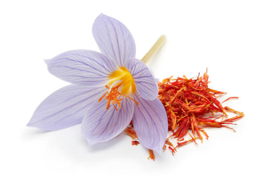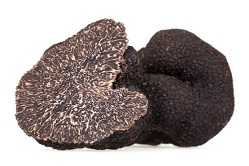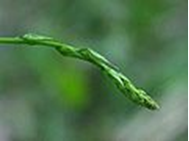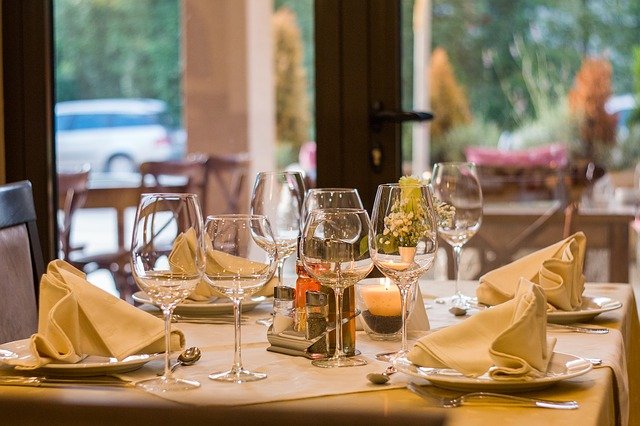In the center of the Occitan region between Gascony and Languedoc, the Tarn has an exceptional gastronomic diversity: pink garlic from Lautrec, foie gras, saffron, fruit and vegetables, eggs, meat, poultry and cheese…
The richness of the Tarn lies not only in the production and diversity of its products but also in the flavours and authenticity of these regional dishes.
FRUIT & VEGETABLES
Pink garlic of Lautrec is a local agricultural production, Label Rouge” since 1966. The first bulbs cultivated have been estimated to date back to the middle ages.
Cahuzac-sur-Vère was also renowned for its garlic and a variety of onion called Lescure-d’Albigeois.
The Tarn valleys contain rich areas suitable for market gardening and orchards. Walnuts, chestnut, plums, apples, cherries, peaches and figs can still be found today…
Once renowned and a source of income, saffron, derived from the pistil of the crocus, is beginning to find its place in the local and emblematic products of the Tarn and the Lauraguais.



The black truffle ” truffes du Tarn ” is nowadays cultivated on the dry lands of Cordes country. It is celebrated every first Sunday of February in Villeneuve sur Vère.
The respounchous are usually picked in spring. This small herbaceous plant is bitter, but the young bleached stems are edible and appreciated by experts, whether in vinaigrette or omelette.
A festival celebrates them at Cordes-sur-Ciel. … (Wikipedia sources)

the respounchou.
From autumn onwards, in the forests of the Lacaune mountains, the Grésigne or in the small local woods, you can find many mushrooms: porcini mushrooms, chanterelles, oyster mushroom, black trumpet mushrooms…
CHARCUTERIE
The Tarn is a land of charcuterie and meat salting.
Among the local specialities: the “galabard”, “le fetge”, a salted and dried pig liver.
In the Lacaune mountains: The “melsát “and the “bougnette de Castres”, a variant of the melsát.
The climate in the south-east of the department, favourable for drying meat, allows the meat to be cured and dried. The Lacaune ham, the Lacaune sausages and salami are a prosperous local processing; the part of the hams destined for trade is labelled in protected geographical indication since 27 August 2015 and sausage and dry sausage since 17 October 2015. (Wikipedia sources)
MEAT
The eastern part of the department is a large breeding area (Limousin, Aubrac and even Gascony breeds). Veal from Aveyron & Ségala have the Label Rouge and Protected Geographical Indication.
Corn farming has enabled the development of ducks Breeding. The Tarn belongs to the area of the IGP label Duck with foie gras from the south-west.
The breeding of other poultry is traditional. Part of the Tarn has the Red and IGP labels: poultry from Languedoc and poultry from Lauragais.
In the past, pigeon houses were very numerous. The Mont-Royal pigeon house perpetuates this tradition. The breeding of 4,200 couples provides local catering.
Among the Tarnese recipes:” the pot-au-feu albigeois” (combination of the classic pot-au-feu with dried beans, local ingredients), duck or goose confit, charcuterie and “gras double à l’albigeoise” (traditional recipe for double fat cooked in white wine and flavoured with saffron).
FISH
The numerous rivers and lakes in the department have favoured the consumption of fresh fish. Trade has made it possible to introduce cod into the Tarnese cooking, such as “Le cassoulet de morue”.
CHEESE
The flagship product is Roquefort cheese (40% of the appellation area is in the Tarn).
Cabécous, small round goat’s cheeses.
The Monts de Lacaune (uncooked pressed tomme) are produced with cow’s milk or sheep’s milk or cow-goat’s milk.Cantal is very present in the Gaillac country where cheese tomes were exchanged for barrels of wine.
DESSERTS
There are many sweet desserts in the Tarn, among which:
The “oreillettes“, the “merveilles“, the” poumpet”, the “petits janots“, the “gimblette”, the “navette albigeoise”.
The “curbelet” is a cylindrical waffle shape and the “croquants de Cordes”, a fine almond tile.
Fruit desserts are essentially pies or croustades with apples, prunes or grapes.
BREAD
In the past, wheat bread and millet cultivated according to the type of land, were the staple food.
Rye was also produced in the Ségala region to which it gave its name. The buckwheat was produced in the Sidobre and the Lacaune Mountains.
Today, the fashion for special breads allows us to find some of these tasty and authentic breads.
SOME TYPICAL AND UNMISSABLE TARNESE DISHES ...
Lautrec’s Pink Garlic Soup
Cassoulet
Cassoulet was originally a staple dish of country people. The elements that make it up come from the production of pork, sausage, tail, rind…
Its origin dates back to the 16th century with the arrival of the bean. Today, there are a multitude of cassoulets, those from Toulouse, Castelnaudary, Carcassonne, the Périgourdin and many others. Interested in its history? Discover it by following the following link:
https://www.frenchcountryfood.com/recipes/with-meat/cassoulet.html
Chichoulet: Ancestor of the famous, dried beans are replaced by chickpeas.
Radishes with salted liver: Emblematic of the city of Albi, the radish with salted liver is the heritage of an authentic cuisine.
Frésinat: Pork stew. Served with sautéed potatoes in parsley.
Double gras: This tripe product cooked with saffron is the traditional dish of the Montagne Noire and Albi where it is cooked with Saffron from the Tarn.
Croustade aux pommes: It is one of the favourite desserts of of many people here in Tarn, traditionally made with apples, prunes or grapes.
Casse-museau: This speciality comes in the form of a small golden ball cooked through. This rustic cake is now part of the heritage of the Monts de Lacaune thanks to bakers from Sidobre.
Jeannots: Triangular biscuits for the Tarn, of which the town of Carmaux has become a speciality.
Croquants de Cordes: Dry almond cakes, a speciality of Cordes-sur-Ciel, north of Albi.
Poumpet: It is a rectangular, fairly flat pastry made of puff pastry, sugar and lemon. This sweet would have been imported by the Saracens during the invasion of Europe; it was originally an Arab cake.
CASSOULET RECIPE
Serves 4
Ingredients
- 350 to 400 g of beans type ingot (of lauragais preferably)
- 2 legs of duck or goose confit, cut in half.
- 4 pieces of 80g of pure pork sausage called “Toulouse”.
- 4 pieces of 50g of pork shank, shoulder or chest
- 250 g pork rind which half will be used after cooking for presenting the cassoulet.
- A little salted lard or bacon
- 1 poultry carcass or some pork bones, onions and carrots
The night before
Soak the beans overnight in cold water.
The next day
Drain the water, put the beans in a saucepan with three liters of cold water and boil for 5 minutes. Turn off the heat, drain the water and set aside beans.
Proceed with the preparation of the broth, again with 3 liters of water, the rinds cut into wide strips, a poultry carcass or some pork bones and, according to your taste a few onions and carrots. Salt and pepper (generously). Cook the soup for an hour and then strain the broth and recover rinds.
In this filtered broth, cook the beans until they are soft but they are left whole. For this, it takes about an hour to boil.
During the cooking of beans, meat preparation
In a large frying pan, degrease pieces of confit, heat and set aside.
In the remaining fat, sauté the Toulouse sausages and set aside.
Fry the pork to be browned and set aside with the other meats.
Drain the beans and reserve the broth warm. Add beans and some garlic cloves, and the double in weight of salted bacon ground together.
Mounting Cassoulet
Bake at 150 ° / 160 ° (Thermostat 5 or 6) and cook for two to three hours.
During cooking, will be formed on top of the casserole a golden-brown crust that you will push in repeatedly (7 times the ancients said).
When the top starts to dry, add a few tablespoons of broth.
If you prepare this stew the day before, it should be warmed in the oven at 150 ° for an hour and a half before serving. Do not forget to add a little broth or, failing that, a few tablespoons of water.
Very important! Serve a bubbling cassoulet in its casserole, spoon it gently without stirring, it will be better and do not hesitate to help yourself for more!
This is a dish that will take you to the popular culinary paradise!
Cooking time
To do this we use the terracotta dish named “Cassolo” (now the “casserole”), which gave its name to the cassoulet, a dish quite hollow of clay for oven.
Line the bottom of the casserole with chunks of rind.
add about a third of beans.
add meat and pour over the rest of the beans.
Arrange sausages by pushing in the beans and sausages to remain above apparent.
Complete the casserole by pouring the hot broth that should just cover the beans.
Pepper mill at the surface and add a tablespoon of duck fat used to brown the meat.
POUMPET RECIPE
Total time: 1 min 25h Serves 6
Ingredients
Puff pastry:
- 500 g flour T55
- 350 g butter
- 1 l of water
- 12 g salt
- 1 sachet of baker’s yeast
- lemon zest
Candied lemon zest:
- 50 g of melted butter
- 2 lemons
- 80 g powdered sugar
- natural lemon flavor extract
Preparation of candied lemon zest
Take the lemon zest and cut into very small dice.
Put in a saucepan with cold water up to it.
Bring to a boil, boil 1 min and drain.
Perform this operation 3 times in all to remove the bitterness from the zest.
Cover one last time with water, just up to the level and put back on the heat with 20 g of sugar.
Bring and keep at a low boil, stirring occasionally with a wooden spoon, until the liquid has completely evaporated.
When all the water has evaporated, the zest should be candied.
Coarsely mash the candied zest with a wooden spoon.
Remove from heat, add 20 g of butter, stir well to melt.
Squeeze a lemon and add the juice to the mixture, along with 1 tbsp. to c. natural lemon flavor.
Mix well.
Add a few more drops of natural lemon flavor.
Puff pastry
In a large bowl, add the flour with the water, salt and the zest of a grated lemon.
Let stand under a clean cloth for 30 min.
Knead the butter so that it takes on the same consistency as the dough.
Roll out the dough into a 2 cm thick rectangle.
Place the kneaded butter in the middle, fold the sides over the butter and spread again 2 times.
Form a large rectangle 2 cm thick.
Preheat the oven to 220 ° C.
Assembly
Finely spread the puff pastry in a rectangle on a sheet of parchment paper.
Divide the rectangle in 3.
With a wooden spoon, remove the candied zest by “wringing” them out and spread over the central part of the dough. Sprinkle with powdered sugar.
Fold the right part over the central part.
Brush generously with part of the butter-lemon-sugar mixture remaining at the bottom of the pan.
Finally fold the left part over the whole.
Add a few drops of lemon extract to the remaining butter-lemon-sugar mixture and brush the top of the cake.
Sprinkle the surface with the rest of the powdered sugar.
Place on a baking sheet with parchment paper below and bake for about 20 min.
Keep an eye on the last few minutes of cooking to get a nice golden color.
Cover with aluminum foil if the cake browns too quickly.
Take out of the oven and possibly sprinkle with icing sugar.
Eat cold or barely warm.


